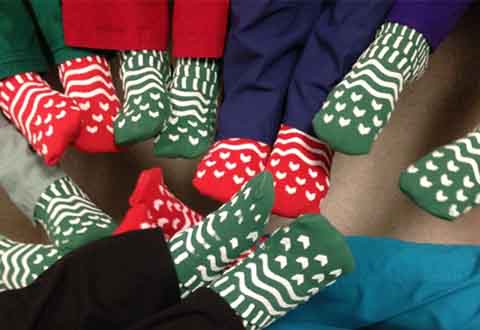VA Boston Facilities Reduce Falls

VA Boston Healthcare System staff members display green and red socks, which indicate a Veteran's fall potential.
The VA Boston Healthcare System took a multidisciplinary approach to falls prevention that has resulted in a substantial reduction in the number of falls, following its participation in a virtual breakthrough series.
“We had an 30 percent decrease in the number of falls, discounting unanticipated physiological falls that cannot be prevented, while falls with major injuries dropped by 50 percent − a significantly higher percentage than we anticipated,” said Vanessa Coronel, R.N., the system’s patient safety nurse and falls prevention coordinator, “and falls, in recent years, have been our most commonly reported adverse event.”
A task force of physicians, nurses, physical therapists, pharmacists, occupational therapists and patient safety staff drew up a list of test changes, to include: sustaining intentional hourly rounding, medication review, reinforcement of safety locks in wheelchairs, and improvement of patient and staff communication. To better convey fall risks, the changes also included use of standardized visual cues and signage at all system facilities.
“On top of striving to provide safer patient care, we project a savings of $250,000, should the changes be sustained for two years,” said Coronel, “based on our business case analysis.”
In November 2012, the multidisciplinary task force, led by Joan Clifford, deputy nurse executive, rolled out the test changes in two system campuses and in different care settings: Brockton (long-term care) and West Roxbury (acute care).
In Brockton, two wards at the Community Living Center implemented the test changes for nine months: Ward 41-B, a 32-bed long-term care unit, and Ward 42-C, a 15-bed hospice/palliative care unit, which also includes short-term rehabilitation patients.
Nurses perform hourly rounds using a checklist that addresses the needs of high-fall risk patients and makes them less likely to take action on their own, which might result in a fall. “The checklist is posted in their rooms and includes items such as assisting them with position changes and placing items in reach,” according to Amy Zamiara, L.P.N., 41-B falls champion.
“Our July 2013 target for the two wards was a checklist compliance rate of 90 percent during hourly rounds, but we reached that goal much earlier − in March,” said Brockton Falls Prevention Coordinator Tom Barnes, R.N.
In West Roxbury, Ward A1, a 23-bed acute care surgical floor, and Ward AG, a 20-bed medical-surgical acute floor, participated in the breakthrough series, coordinated by Associate Chief Nurse James Doelling, R.N.
Aside from hourly rounding, Ward A1 employs visual cues and signage to increase staff awareness of high-fall risk patients. Posters of a pair of non-skid red socks, indicating high risk for falls, are placed at the entrance of the patient’s room and above the patient’s bed. The patients are also to wear red non-skid socks.
“Despite the nature of our patient population, this ward has had no falls with major injuries for years,” said Nurse Manager Gilda Cain, R.N. She also noted that Ward A1 handles patients from 11 specialties including orthopedics, urology and rehabilitation.
“In March 2013, red non-skid socks were made standard in all system facilities as a visual cue to indicate high fall risk, while green non-skid socks indicate low fall risk,” said Ellen McCarthy, R.N., the ward’s falls prevention champion.
Learn more
Read the entire story in the March/April edition of TIPS



















